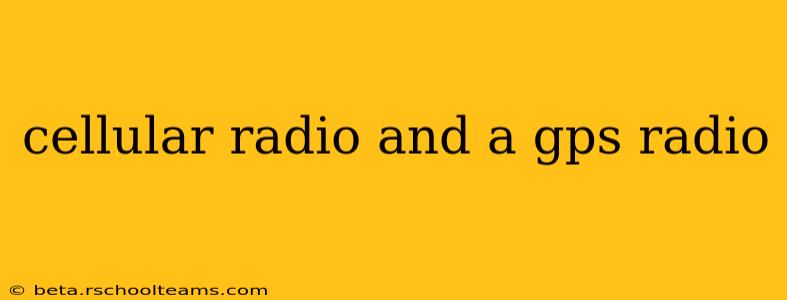Cellular radio and GPS radio are both wireless communication technologies, but they serve vastly different purposes and operate on fundamentally distinct principles. Understanding their key differences is crucial for anyone working with wireless systems or simply curious about how these technologies function. This article will delve into the specifics of each technology, highlighting their key features, applications, and the reasons behind their contrasting capabilities.
What is Cellular Radio?
Cellular radio, the technology behind our mobile phones, is a two-way communication system that utilizes a network of base stations (cell towers) to provide voice and data services over a wide geographical area. It relies on a complex system of frequency allocation, switching, and signal processing to connect users to the network and route calls and data.
Key Features of Cellular Radio:
- Two-way communication: Cellular networks allow for both sending and receiving data, enabling voice calls, text messages, and internet access.
- Wide area coverage: The network of cell towers provides extensive geographic coverage.
- Dynamic frequency allocation: The system efficiently utilizes available frequencies, adapting to changing network demands.
- High data rates: Modern cellular networks (4G, 5G) support extremely high data transmission rates.
- Mobility: Users can move freely within the coverage area while maintaining a connection.
What is GPS Radio?
GPS radio, or more accurately, GPS receivers, utilize signals transmitted from a constellation of satellites orbiting the Earth to determine precise location. Unlike cellular radio, GPS is a one-way system; the receiver passively receives signals, but it does not transmit data back to the satellites.
Key Features of GPS Radio:
- One-way communication: GPS receivers only receive signals, not transmit them.
- Global coverage: GPS satellites provide global coverage, barring obstructions like dense foliage or buildings.
- Precise positioning: GPS can pinpoint a location with remarkable accuracy (within meters).
- Time synchronization: GPS signals also provide highly accurate time information.
- Independent of terrestrial infrastructure: GPS functions independently of cell towers or other ground-based infrastructure.
How are Cellular Radio and GPS Radio Different?
The most fundamental difference lies in their purpose and functionality:
- Purpose: Cellular radio facilitates communication, while GPS determines location.
- Communication type: Cellular radio is two-way, whereas GPS is one-way.
- Signal source: Cellular radio uses terrestrial base stations, while GPS uses orbiting satellites.
- Data type: Cellular radio transmits voice, data, and multimedia, while GPS transmits location and time information.
- Accuracy: Cellular triangulation can provide approximate location, but GPS offers much higher accuracy.
What are the Applications of Cellular Radio?
Cellular radio underpins the global mobile communication infrastructure. Its applications are virtually limitless, including:
- Voice calls: Making and receiving phone calls.
- Text messaging: Sending and receiving short messages.
- Mobile internet: Accessing the internet on mobile devices.
- Location-based services: Utilizing location information for mapping, navigation, and other services.
- Machine-to-machine (M2M) communication: Connecting devices for remote monitoring and control.
What are the Applications of GPS Radio?
GPS technology has revolutionized navigation and location-based services. Its key applications include:
- Navigation: Guiding vehicles, aircraft, and ships.
- Mapping: Providing precise location information for maps and geographic information systems (GIS).
- Surveying: Accurately measuring distances and positions.
- Tracking: Monitoring the movement of assets, vehicles, and people.
- Timing: Providing precise time synchronization for various applications.
Can Cellular Radio be Used for Positioning?
Yes, cellular networks can be used for positioning, often called cell tower triangulation. However, the accuracy is typically lower than GPS, ranging from tens to hundreds of meters. Modern cellular networks incorporate technologies like Assisted GPS (A-GPS) and other location-based services to improve accuracy.
Can GPS be Used for Communication?
No, standard GPS receivers cannot be used for communication. They only receive signals; they do not transmit. However, some systems combine GPS with communication capabilities, such as GPS trackers that transmit location data via cellular or satellite networks.
This detailed comparison clarifies the distinctions between cellular and GPS radio technologies, highlighting their unique characteristics, applications, and underlying principles. Understanding these differences is essential for appreciating the role each technology plays in our modern world.
